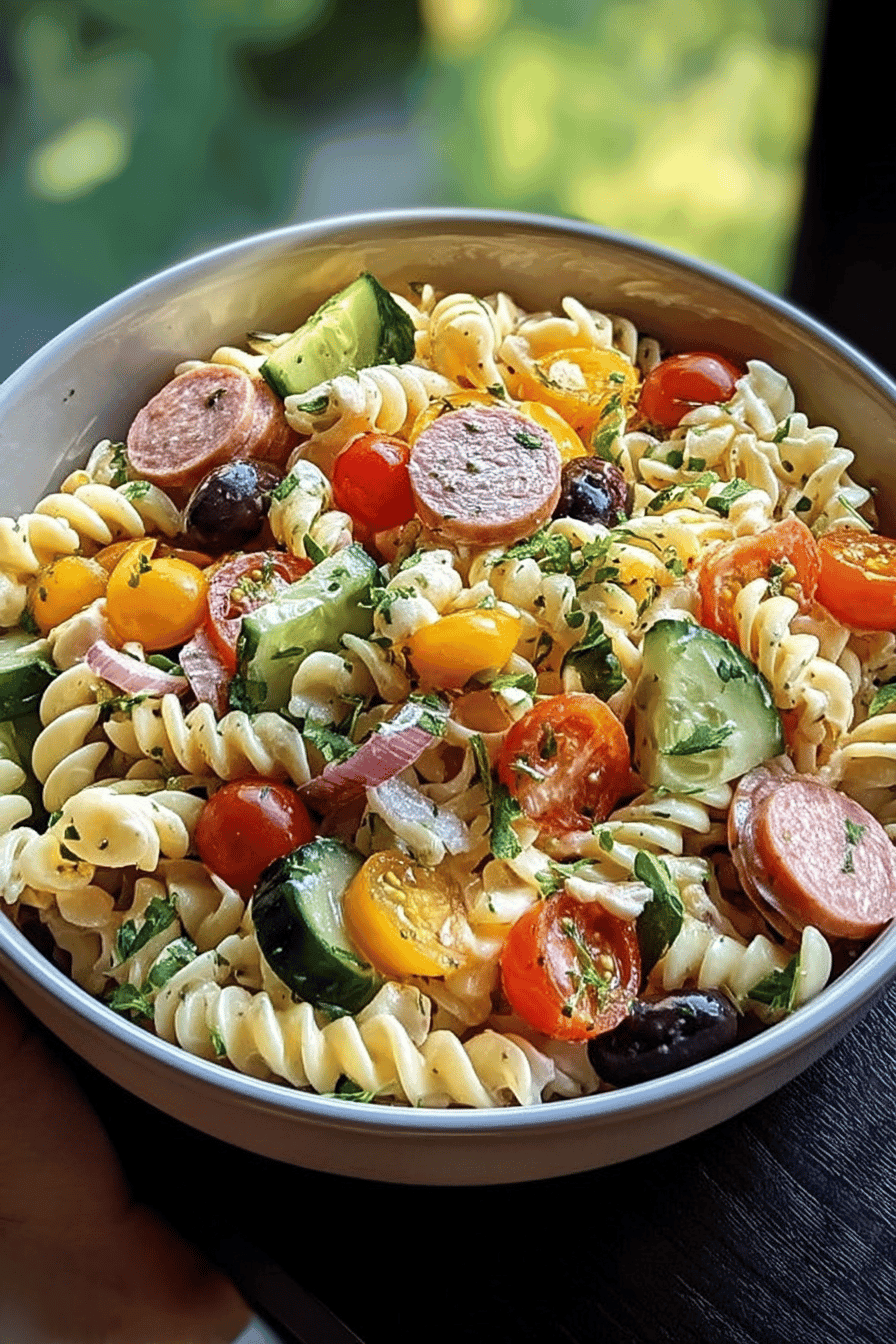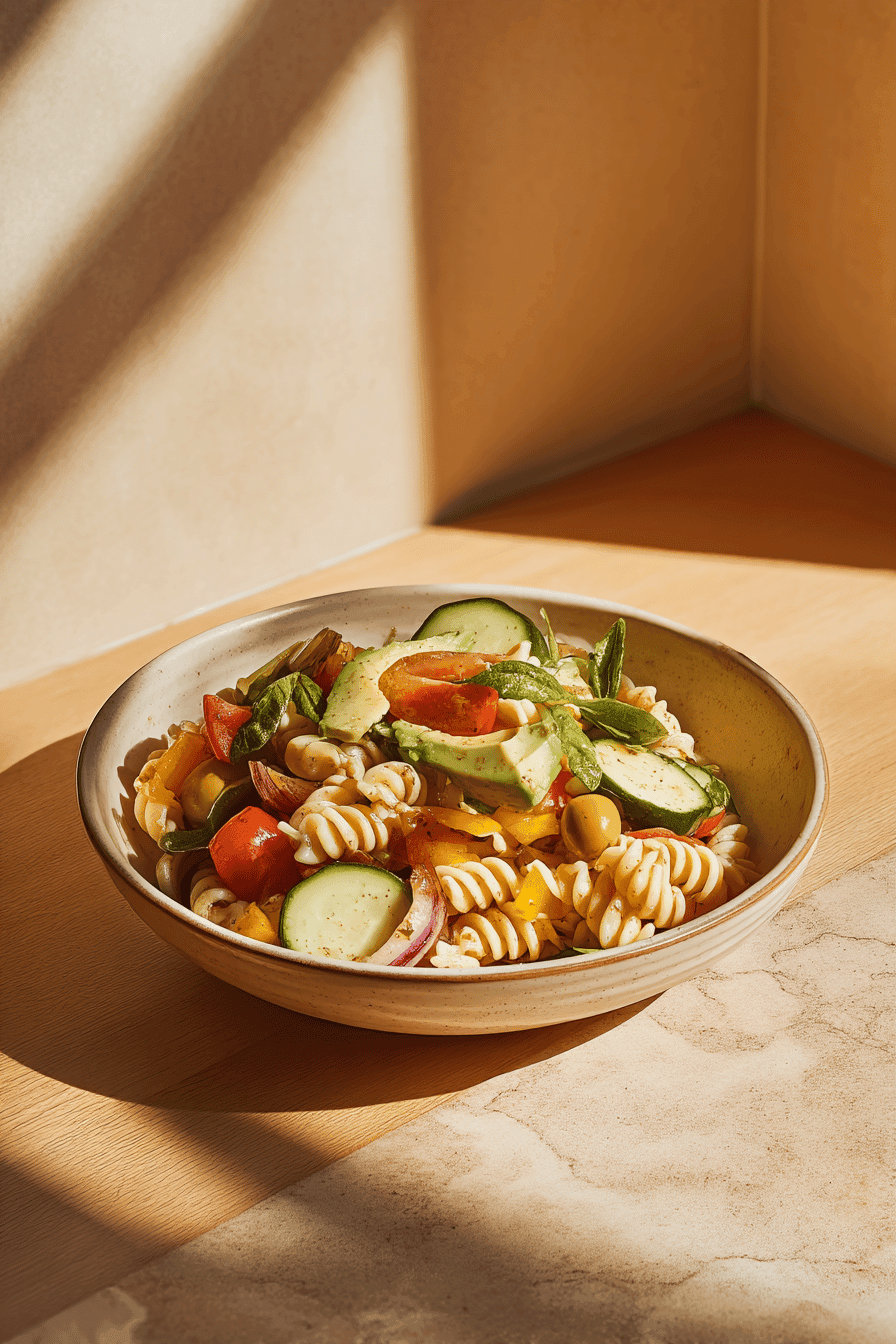Benefits and Advantages of Pasta Salad
Pasta salad offers a variety of benefits that make it a popular option for meals and gatherings. Its simplicity in preparation allows even those new to cooking to create a flavorful dish quickly and with minimal effort. The versatility of pasta salad means it can be customized to fit many dietary goals and tastes, incorporating fresh vegetables, lean proteins, and healthy oils for a well-balanced, nutritious meal.
The use of fresh, wholesome ingredients provides essential vitamins, minerals, and dietary fiber, which contribute to overall health and well-being. It can be easily adapted to meet vegan, gluten-free, and low-calorie preferences, widening its appeal. Whether served as a side dish or a light main course, pasta salad is refreshing, satisfying, and excellent for picnics, barbecues, or everyday meals.
“This dish combines convenience, nutrition, and vibrant flavors, making pasta salad a flexible choice for diverse diets and occasions.”
The balance of tangy dressing and fresh herbs enhances the eating experience, while its cold serving temperature makes it especially well-suited for warm-weather dining. Its ability to hold up well when made ahead also adds to its convenience.
Jump To
- 1. Benefits and Advantages of Pasta Salad
- 2. Essential Ingredients for Pasta Salad
- 3. Dietary Substitutions to Customize Your Pasta Salad
- 4. How to Prepare the Perfect Pasta Salad: Step-by-Step Guide
- 5. Advanced Tips and Variations
- 6. How to Store Pasta Salad: Best Practices
- 7. Nutritional Value of Pasta Salad
- 8. FAQs: Frequently Asked Questions About Pasta Salad
- 9. Simple and Flavorful Pasta Salad Recipe for Quick and Easy Meals
Essential Ingredients for Pasta Salad
- 1 pound (454 g) dried pasta such as fusilli, penne, rotini, or farfalle
- 1 cup (about 1 medium) sliced bell pepper (red, orange, or yellow)
- 1 cup (about 1/2 medium) thinly sliced zucchini
- 1 cup halved cherry or grape tomatoes (about 10 oz/280 g)
- 1/3 cup thinly sliced green onions (5 to 6 green onions)
- 1/4 cup sliced pepperoncini or banana peppers (optional)
- 1 cup (4 ounces/113 g) halved mixed olives, such as Kalamata or green olives
- 1 cup (2 ounces/57 g) grated parmesan cheese or other hard cheese (optional)
- 1 cup (6 ounces/170 g) fresh mozzarella balls, chopped (optional, can omit for vegan version)
- 1/3 cup fresh herbs such as parsley, basil, or a combination (optional)
Homemade Dressing
- 1/3 cup (80 ml) red wine vinegar, white wine vinegar, or champagne vinegar
- 1/2 teaspoon fine sea salt, plus more to taste
- 1/2 teaspoon freshly ground black pepper
- 1/2 teaspoon dried oregano or Italian seasoning
- 2 to 3 tablespoons juice from the pepperoncini jar (optional, adds tanginess)
- 1/2 cup (120 ml) extra-virgin olive oil
Alternate dressing variations can include lemon juice, Dijon mustard, minced garlic, or red pepper flakes for added complexity.
Dietary Substitutions to Customize Your Pasta Salad
Adapting this pasta salad to various dietary needs is simple and rewarding. For gluten-free diets, substitute traditional pasta with gluten-free options such as rice, corn, or quinoa-based pasta. Vegan adaptations can be achieved by omitting dairy cheese and replacing it with diced olives, sun-dried tomatoes, or avocado for creaminess.
Those watching calorie intake may reduce the amount of oil in the dressing and increase vegetable content for more volume with fewer calories. To add protein, options include grilled chicken, chickpeas, or tofu, thus making it suitable for vegetarians or varied palates.
Allergy considerations like nut or seed toppings can be accommodated by omission or substitution, while sodium-sensitive individuals should opt for low-sodium dressings and fresh ingredients instead of processed items.
“These substitutions maintain the salad’s flavorful profile while supporting individual health goals and preferences.”
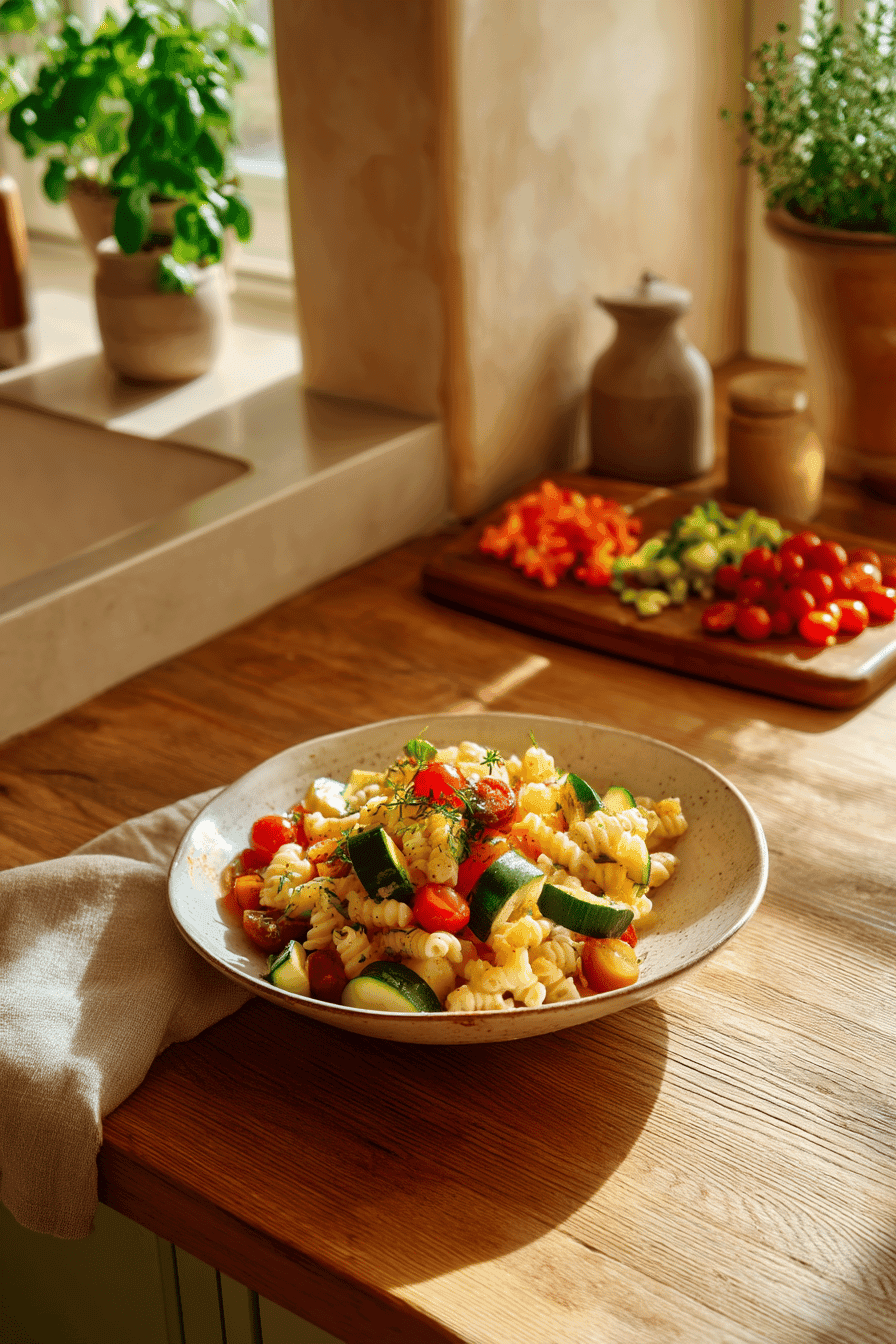
How to Prepare the Perfect Pasta Salad: Step-by-Step Guide
- Cook Pasta: Boil your pasta of choice in salted water until al dente; drain and rinse under cold water to halt cooking and remove starches which prevents the salad from becoming sticky.
- Prep Vegetables: Wash and chop bell peppers, zucchini, tomatoes, and green onions into bite-sized pieces, ensuring an even texture.
- Combine Pasta and Vegetables: In a large bowl, mix the cooled pasta with the chopped vegetables for balanced distribution.
- Make Dressing: Whisk together vinegar, olive oil, salt, pepper, oregano, and optional pepperoncini juice. Adjust seasoning to taste; substitute vegan mayonnaise or gluten-free vinegar if needed.
- Dress the Salad: Pour the dressing over the pasta-vegetable mix and toss gently to coat everything uniformly without crushing ingredients.
- Add Protein: Incorporate chickpeas, tofu, grilled chicken, or nuts to boost texture and nutritional value.
- Chill: Refrigerate the salad for at least 30 minutes, preferably longer, to meld flavors and enhance freshness.
- Garnish Before Serving: Sprinkle fresh herbs like parsley or basil on top to add aroma and vibrant color.
This method guarantees a tasty, refreshing pasta salad suited to many budgets, occasions, or dietary preferences.
For more recipes that balance health and flavor, visit our easy Healthy Turkey Sloppy Joes.
Learn additional key tips to perfect your preparation by reviewing this detailed guide on how to make the best pasta salad.
Advanced Tips and Variations
To keep your pasta salad vibrant and flavorful, consider these advanced tips and variations:
- Homemade Dressings: Make your own vinaigrettes to control the acidity and sweetness. Adding herbs like dill, oregano, or smoked paprika can offer delightful new flavors.
- Roasted Vegetables: Introduce depth by adding roasted zucchini, eggplant, or bell peppers to create smoky undertones.
- Crunchy Elements: Top your pasta salad with toasted pine nuts, almonds, or sunflower seeds for texture, while considering any allergy restrictions.
- Themed Variations: Create a Mediterranean version with kalamata olives and feta cheese, or experiment with Asian-inspired ingredients using sesame oil and soy sauce.
- Seasonal Produce: Choose fresh, seasonal vegetables to maximize flavor, color, and nutrient content.
- Texture Adjustments: Modify the ratio of pasta to vegetables and dressing to achieve creamy or lighter results suited to preference.
“These tweaks and creative swaps help maintain pasta salad’s freshness and appeal, all while supporting your personal taste and dietary needs.”
How to Store Pasta Salad: Best Practices
Proper storage keeps your pasta salad fresh, tasty, and safe to eat over several days:
- Store the salad in an airtight container in the refrigerator to prevent moisture loss and contamination.
- Consume refrigerated pasta salad within 3 to 5 days for the best flavor and safety.
- If freezing, separate the dressing from the pasta salad to avoid sogginess; freeze pasta and mix-ins in a freezer-safe container.
- Thaw frozen pasta salad in the refrigerator overnight before serving.
- Add dressing fresh after thawing and toss well to combine.
- Reheating pasta salad is generally not recommended, but if warm elements are desired, heat individual components separately.
| Storage Type | Duration | Notes |
|---|---|---|
| Refrigeration | 3 to 5 days | Keep in airtight container for freshness |
| Freezing | Up to 1 month | Freeze pasta and veggies separately from dressing |
Nutritional Value of Pasta Salad
Pasta salad provides a well-rounded nutritional profile suitable for a wholesome meal or side dish:
| Nutrient | Approximate Per Serving | Health Benefit |
|---|---|---|
| Calories | 300–363 kcal | Provides energy necessary for daily activities |
| Total Fat | 11–19 g | Heart-healthy fats from olive oil support brain and cell functions |
| Saturated Fat | 5 g | Moderation aids in balanced dietary fat intake |
| Carbohydrates | 36–44 g | Provides fiber and energy, supports digestive health |
| Dietary Fiber | 2–3 g | Improves digestion and steadies blood sugar levels |
| Protein | 7–12 g | Supports muscle maintenance and repair |
| Sodium | 500–550 mg | Balances fluids but should be monitored for sensitive individuals |
The vitamins and minerals are enhanced by fresh vegetables and herbs, which contribute antioxidants and nutrients like vitamin C and potassium. Using whole grain or gluten-free pasta can improve fiber and nutrient content further. Learn more about the health benefits of Mediterranean diet vegetables and the nutritional information of mozzarella cheese for deeper insights on key ingredients.
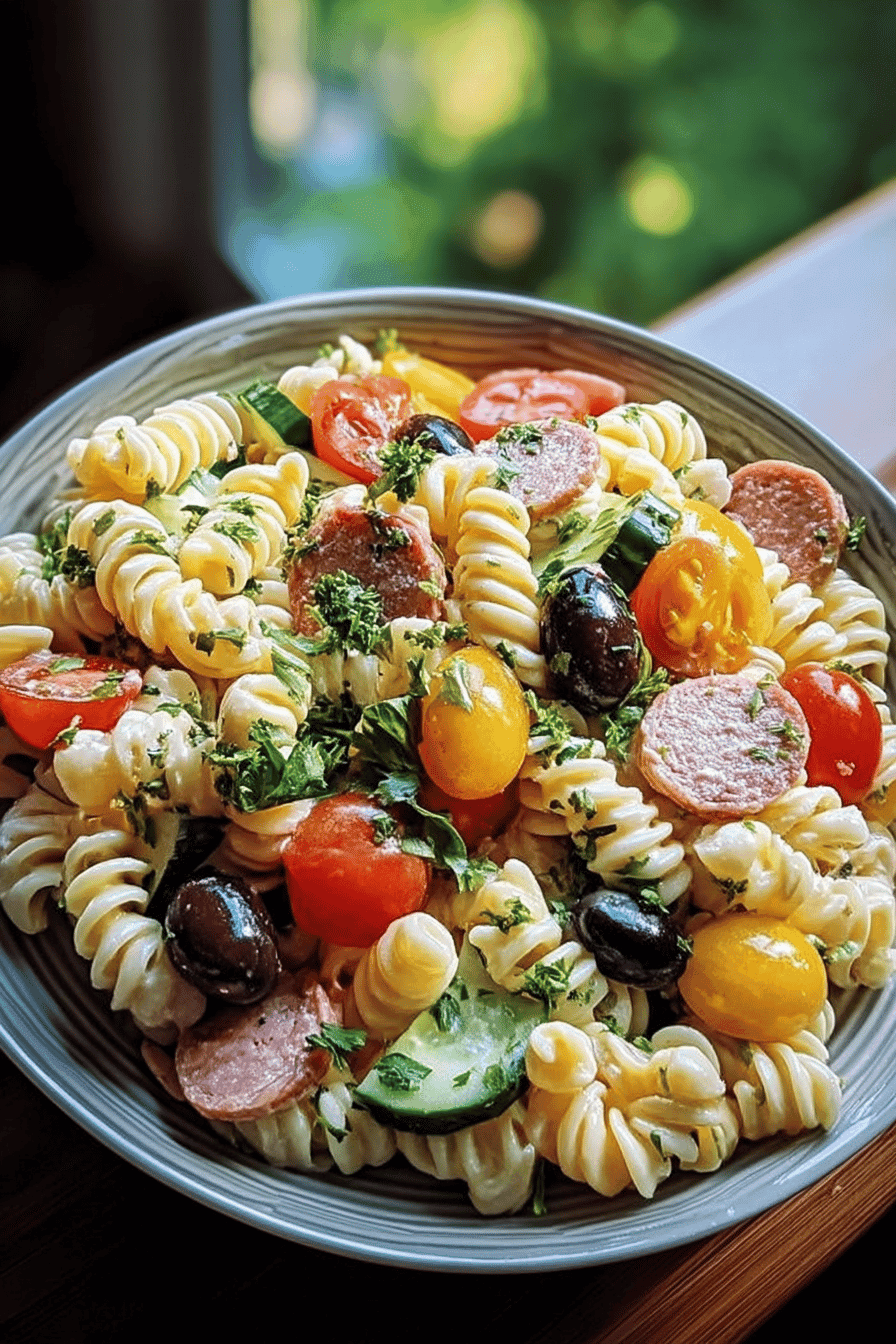
FAQs: Frequently Asked Questions About Pasta Salad
What is the best type of pasta to use for pasta salad?
Short, sturdy pasta shapes like penne, fusilli, rotini, and farfalle work best for pasta salad. These shapes have ridges and crevices that hold onto the dressing and other ingredients well. Orzo and pearl couscous are also good options if you prefer smaller pasta. Avoid thin or delicate pasta like spaghetti, as they may become mushy or fail to absorb the flavors as effectively.
Should I rinse pasta after cooking for pasta salad?
Yes, rinsing the cooked pasta under cold water stops the cooking process and removes excess starch. This helps prevent the pasta from sticking together and allows the dressing to coat the noodles better. Make sure to drain the pasta thoroughly before mixing it with the other ingredients.
How long can I store pasta salad in the refrigerator?
Pasta salad can be stored in an airtight container in the refrigerator for 3 to 5 days. Keeping it chilled helps maintain freshness and flavor. If the salad contains fresh herbs or crunchy nuts, it’s best to add those just before serving to keep their texture intact.
Can I make pasta salad ahead of time, and how should I store it?
You can prepare pasta salad up to a day in advance, which allows the flavors to blend nicely. For best results, toss the salad with most ingredients but add delicate items like fresh herbs, cheese, or nuts just before serving to keep them fresh. Store the salad in a sealed container in the fridge.
What are some easy substitutions to make pasta salad vegan or gluten-free?
To make a vegan pasta salad, omit cheese or replace it with diced olives, sun-dried tomatoes, or avocado. For a gluten-free version, select gluten-free pasta varieties made from rice, corn, or quinoa. These swaps maintain flavor and texture while accommodating dietary needs.
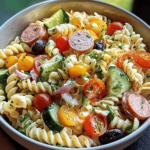
Simple and Flavorful Pasta Salad Recipe for Quick and Easy Meals
- Total Time: 20 minutes or more including chilling
- Yield: Serves 8–10 1x
- Diet: Vegetarian
Description
🍝 This Simple and Flavorful Pasta Salad is a versatile and refreshing dish packed with fresh vegetables, olives, and cheese.
🥗 Perfect for quick meals or gatherings, it offers a tangy homemade vinaigrette that enhances every bite and holds well as a make-ahead option.
Ingredients
1 pound dried pasta such as fusilli, penne, rotini, or farfalle
1 cup sliced bell pepper (red, orange, or yellow)
1 cup thinly sliced zucchini
1 cup halved cherry or grape tomatoes
1/3 cup thinly sliced green onions
1/4 cup sliced pepperoncini or banana peppers (optional)
1 cup halved mixed olives, such as Kalamata or green olives
1 cup grated parmesan cheese (optional)
1 cup fresh mozzarella balls, chopped (optional)
1/3 cup fresh herbs such as parsley, basil, or a combination (optional)
1/3 cup red wine vinegar, white wine vinegar, or champagne vinegar
1/2 teaspoon fine sea salt, plus more to taste
1/2 teaspoon freshly ground black pepper
1/2 teaspoon dried oregano or Italian seasoning
2 to 3 tablespoons juice from the pepperoncini jar (optional)
1/2 cup extra-virgin olive oil
Optional additions: 1½ cups chickpeas (drained and rinsed), 2 cups arugula or spinach, 1 cup sliced Persian cucumbers, 1/4 cup pine nuts or nuts of choice, 1/2 cup minced fresh herbs like parsley, basil, and mint
Instructions
1. Bring a large pot of salted water to a boil. Cook pasta according to package instructions until tender but firm, about 6 to 10 minutes. Drain and rinse under cold water to stop cooking and remove excess starch. Drain well and toss with a little olive oil, then let cool to room temperature if possible.
2. In a large bowl, whisk together vinegar, salt, pepper, oregano, pepperoncini juice (if using), and olive oil.
3. Add the drained pasta to the dressing and toss to coat evenly.
4. Stir in bell pepper, zucchini, cherry tomatoes, green onions, pepperoncini (if using), olives, parmesan, mozzarella, and fresh herbs. Add any additional vegetables or mix-ins like chickpeas, arugula, cucumbers, pine nuts, or herbs.
5. Adjust seasoning with extra salt, pepper, or lemon juice as needed.
6. Serve immediately, or refrigerate for at least 30 minutes or preferably several hours or overnight to allow flavors to meld. Add delicate ingredients like fresh herbs or pine nuts just before serving if prepared ahead.
Notes
🍝 Rinsing pasta after cooking helps remove starch and prevents clumping.
⏳ Making the salad a day ahead allows flavors to meld and improves taste.
🥗 Store leftovers in an airtight container in the refrigerator for 3 to 5 days for freshness and convenience.
- Prep Time: 10 minutes
- Chill time: 30 minutes to overnight
- Cook Time: 10 minutes
- Category: Salad
- Method: Boiling and Tossing
- Cuisine: American
Nutrition
- Serving Size: About 1 cup
- Calories: 300-363 kcal
- Sodium: 500-550 mg
- Fat: 11-19 g
- Saturated Fat: 5 g
- Carbohydrates: 36-44 g
- Fiber: 2-3 g
- Protein: 7-12 g
- Cholesterol: 18 mg
Keywords: Pasta Salad, Quick Meals, Flavorful Salad, Easy Pasta Salad

